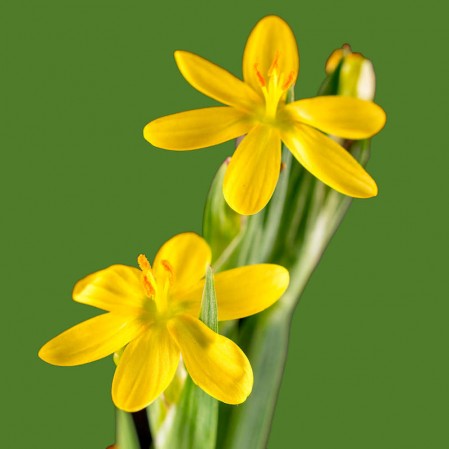Golden Blue Eyed Grass Seeds
Sisyrinchium californicum
- HOW TO GROW
- FAST FACTS
HOW TO GROW
Sowing: Direct sow in late fall, pressing into the surface of the soil. For spring planting, mix the seeds with moist sand and store in the refrigerator for 60 days before planting. Keep the soil lightly moist until germination, which usually occurs within 4-6 weeks.
Growing: Water seedlings regularly until they become established. This plant prefers consistently moist soil, though it must be well-drained. Though established plants tolerate some drought, watering during especially dry weather will improve its blooming. Unless cut back after blooming, this plant will self-sow. Mature plants can be divided. This plant attracts bees.
Harvesting: For cut flowers, choose stems with flowers that have just opened. Place in water immediately.
Seed Saving: After the flowers fade, round seed pods will develop that mature from green to black. When ripe, they will contain mature black seeds. Remove the ripe seed pods and spread them out to dry away from direct sunlight. Crush the dried pods slightly to open them, then separate the seed from the plant material. Store the cleaned seed in a cool, dry place.
FAST FACTS
Common Names: Yellow-eyed Grass, California Golden-eyed Grass
Latin Name: Sisyrinchium californicum
Species Origin: US Native Wildflower
Type: Native Wildflowers
Life Cycle: Perennial
USDA Zones: 6, 7, 8, 9, 10
US Regions: California, Mountain
Seeds per Ounce: 25,000
Stratification: Cold/Wet for 8 Weeks
Germination Ease: Stratify 8 Weeks
Sunlight: Full Sun, Part Sun
Height: 9 Inches
Color: Yellow
Bloom Season: Blooms Late Spring
DESCRIPTION

HOW TO GROW
Sowing: Direct sow in late fall, pressing into the surface of the soil. For spring planting, mix the seeds with moist sand and store in the refrigerator for 60 days before planting. Keep the soil lightly moist until germination, which usually occurs within 4-6 weeks.
Growing: Water seedlings regularly until they become established. This plant prefers consistently moist soil, though it must be well-drained. Though established plants tolerate some drought, watering during especially dry weather will improve its blooming. Unless cut back after blooming, this plant will self-sow. Mature plants can be divided. This plant attracts bees.
Harvesting: For cut flowers, choose stems with flowers that have just opened. Place in water immediately.
Seed Saving: After the flowers fade, round seed pods will develop that mature from green to black. When ripe, they will contain mature black seeds. Remove the ripe seed pods and spread them out to dry away from direct sunlight. Crush the dried pods slightly to open them, then separate the seed from the plant material. Store the cleaned seed in a cool, dry place.
FAST FACTS
Common Names: Yellow-eyed Grass, California Golden-eyed Grass
Latin Name: Sisyrinchium californicum
Species Origin: US Native Wildflower
Type: Native Wildflowers
Life Cycle: Perennial
USDA Zones: 6, 7, 8, 9, 10
US Regions: California, Mountain
Seeds per Ounce: 25,000
Stratification: Cold/Wet for 8 Weeks
Germination Ease: Stratify 8 Weeks
Sunlight: Full Sun, Part Sun
Height: 9 Inches
Color: Yellow
Bloom Season: Blooms Late Spring





